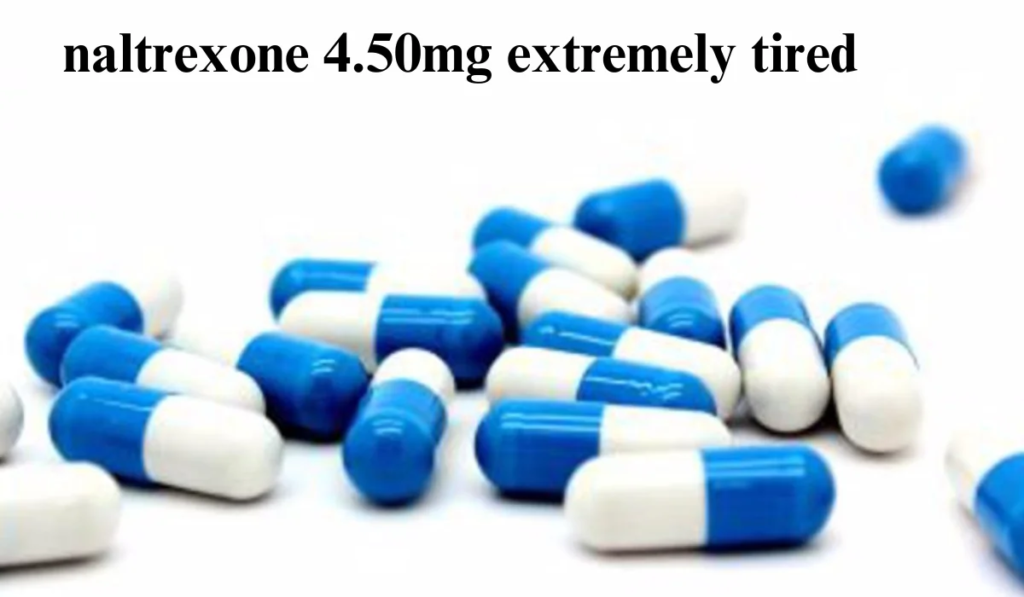Understanding Naltrexone 4.50mg Side Effects
Comprehensive Overview of naltrexone 4.50mg side effects
Naltrexone, a medication primarily used to address alcohol and opioid dependence, plays a crucial role in addiction treatment by reducing cravings and promoting abstinence. Its primary mechanism involves blocking opioid receptors in the brain, which helps diminish withdrawal symptoms and cravings related to addiction.
At a lower dosage of naltrexone 4.50mg side effects is also utilized for off-label purposes, such as managing chronic pain and autoimmune disorders. This article delves into the side effects associated with Naltrexone 4.50 mg, providing essential insights for those considering or currently using this medication.
Understanding Naltrexone’s Role in Addiction Treatment
To fully grasp the potential side effects of Naltrexone 4.50 mg, it is helpful to understand the medication’s primary function and its impact on addiction. Naltrexone is specifically designed to aid individuals struggling with alcohol and opioid dependence. By mitigating cravings and supporting recovery, it offers a vital tool in the battle against addiction. Familiarizing yourself with these aspects can enhance your awareness of both the medication’s benefits and possible side effects.
What Is Naltrexone?

Naltrexone is classified as an opioid antagonist. It binds to opioid receptors in the brain but does not activate them, thus preventing substances like alcohol and opioids from producing their euphoric effects. Available in various forms, including oral tablets, injectable solutions, and implants, Naltrexone has been a part of addiction treatment since its FDA approval in 1984 for opioid dependence and its subsequent approval in 1994 for alcohol dependence. While its primary uses are well-documented, the drug’s application has broadened, often involving off-label uses that necessitate careful medical supervision.
Mechanism of Action for Naltrexone 4.50 mg
At the 4.50 mg dosage, Naltrexone is believed to influence the immune system and reduce inflammation, leading to its application in managing conditions such as fibromyalgia, multiple sclerosis, and Crohn’s disease. Although these uses are off-label, ongoing research into low-dose Naltrexone (LDN) suggests potential benefits in conditions characterized by an overactive immune system. By regulating natural endorphin production, LDN may offer pain relief and inflammation reduction. However, extensive clinical trials are needed to confirm these benefits and develop standardized treatment guidelines.
Addressing Persistent Fatigue with Naltrexone 4.50 mg
While naltrexone 4.50mg side effects in treating addiction by blocking opioid receptors and alleviating cravings, it may cause extreme fatigue in some individuals. This side effect may be related to how Naltrexone interacts with the body’s physiological processes. Variations in individual responses, including sensitivity to the medication, can result in side effects such as headaches and dizziness. Additionally, underlying health conditions or concurrent medications may contribute to feelings of extreme tiredness.
It is important to monitor these symptoms and consult with healthcare professionals to manage them effectively. Regular check-ins can help address any issues and adjust the treatment plan as needed.
Common Side Effects of Naltrexone 4.50 mg
Like all medications, Naltrexone can lead to side effects, although not everyone will experience them. Being informed about these potential risks can help you make well-informed decisions regarding your treatment. For instance, consuming alcohol while taking Naltrexone can precipitate severe withdrawal symptoms. Therefore, adopting strategies to avoid alcohol consumption is crucial for the medication’s effectiveness.
Gastrointestinal Issues
A frequent side effect of Naltrexone 4.50 mg is gastrointestinal discomfort, which may include:
- Nausea
- Vomiting
- Diarrhea
- Abdominal pain
These symptoms are usually mild and tend to diminish as your body adapts to the medication. If gastrointestinal issues persist or become severe, it is advisable to consult your healthcare provider. Some patients find relief by taking the medication with food, which can help reduce these side effects. Maintaining a balanced diet and staying hydrated may also alleviate discomfort. Should symptoms continue, your healthcare provider may adjust your dosage or recommend additional treatments.
Sleep Disturbances

Another potential side effect is sleep disturbances, which can manifest as:
- Insomnia
- Vivid dreams
- Night sweats
These issues, while often manageable, can impact overall well-being. To mitigate sleep disturbances, maintaining a consistent sleep schedule and practicing good sleep hygiene are beneficial. Avoiding stimulants such as caffeine and heavy meals before bedtime can also help improve sleep quality. If these disturbances persist, consulting your healthcare provider may lead to alternative therapies or adjustments to your treatment plan.
By understanding these side effects and working closely with healthcare professionals, you can better navigate the use of Naltrexone 4.50 mg and optimize its benefits for managing addiction and related conditions.
Less Common Yet Serious Side Effects of Naltrexone 4.50 mg
While the side effects of Naltrexone 4.50 mg are generally mild for most users, there are some less common but potentially severe reactions that warrant immediate medical attention. Recognizing these rare side effects early is crucial for preventing complications and ensuring appropriate care. If you experience persistent extreme tiredness or other serious symptoms, consulting a healthcare provider is essential for effective monitoring and management.
Liver Function Concerns
Naltrexone 4.50 mg can impact liver function, particularly at higher doses. Individuals should be vigilant for signs of liver distress, which can include:
- yellowing of the skin or eyes Jaundice, characterized
- Dark-colored urine
- Pale or clay-colored stools
- Severe abdominal pain
If you notice any of these symptoms, it’s important to stop taking the medication and seek immediate medical advice. Regular liver function tests are often recommended for those on long-term Naltrexone therapy to monitor liver health. Your healthcare provider will assess liver enzyme levels to ensure they remain within safe limits.
Patients with existing liver conditions need to exercise extra caution when using Naltrexone 4.50 mg. It is important to discuss your complete medical history with your healthcare provider to evaluate if this medication is appropriate for you. Early detection and management of liver-related issues are key to preventing long-term damage and ensuring effective treatment outcomes.
Allergic Reactions

Although rare, allergic reactions to Naltrexone 4.50 mg can occur. Symptoms of an allergic reaction may include:
- Rash
- Itching or swelling, particularly of the face, tongue, or throat
- Severe dizziness
- Difficulty breathing
If you experience any of these symptoms, it is crucial to seek emergency medical help immediately. Allergic reactions can escalate rapidly and require prompt treatment to avoid severe complications.
Before initiating Naltrexone treatment, inform your healthcare provider of any known drug allergies. This information helps assess your risk and guides appropriate management strategies if an allergic reaction occurs. For those with a history of severe allergies, carrying an emergency allergy kit with antihistamines and an epinephrine injector can be a critical precaution.
By being aware of these less common but serious side effects of Naltrexone 4.50 mg, you can take proactive steps to ensure safe and effective use of the medication. Regular consultations with healthcare professionals and monitoring for potential issues are essential for optimal treatment and health management.
Special Considerations and Warnings for Naltrexone 4.50 mg
When using Naltrexone 4.50 mg, certain factors can influence its effectiveness and safety. Understanding these considerations is crucial for safe medication use and optimal results. This section will address key issues such as pre-existing conditions and potential drug interactions, which can impact the experience of side effects and overall treatment efficacy.
Pre-existing Medical Conditions
If you have underlying health conditions such as liver disease, kidney disease, or mental health disorders, extra caution is necessary when using Naltrexone 4.50 mg. These conditions can affect how the medication is metabolized and might increase the risk of adverse effects. It is important for your healthcare provider to review your complete medical history to determine whether Naltrexone is an appropriate treatment option for you.
For individuals with chronic illnesses, close monitoring and possible dosage adjustments may be required. Regular medical check-ups and open communication with your healthcare provider are essential to manage any potential risks associated with Naltrexone. Always keep your provider informed about any changes in your health status or new symptoms that arise during treatment.
Potential Drug Interactions
naltrexone 4.50mg side effects with other medications, which may either enhance the risk of side effects or reduce the medication’s effectiveness. To prevent these issues, it is vital to provide your healthcare provider with a complete list of all medications you are currently taking, including prescription drugs, over-the-counter medications, and dietary supplements.
Some drugs may necessitate adjustments in dosage or alternative treatments to avoid adverse interactions. Your healthcare provider can offer guidance on managing potential drug interactions and help you adjust your medication regimen as needed. Regularly reviewing and updating your medication list with your provider helps ensure the safety and efficacy of your treatment.
Additional Considerations
In addition to managing pre-existing conditions and drug interactions, it’s worth noting that Naltrexone 4.50 mg may also contribute to reducing binge eating behaviors. This potential benefit can be part of a broader treatment plan, but should be discussed with your healthcare provider to tailor your approach based on individual needs and conditions.
By taking these special considerations into account, you can better navigate the use of Naltrexone 4.50 mg and minimize risks while maximizing the benefits of the medication.
Strategies for Managing Naltrexone 4.50 mg Side Effects

Experiencing side effects while using Naltrexone 4.50 mg can be challenging, but there are several strategies to manage these effects effectively. By proactively addressing side effects, you can enhance your overall quality of life and improve the success of your treatment.
Lifestyle Modifications
Making simple lifestyle adjustments can significantly reduce some side effects associated with Naltrexone 4.50 mg:
- Dietary Adjustments: Consuming smaller, more frequent meals can help alleviate gastrointestinal discomfort. Avoiding caffeine and alcohol may also improve sleep quality.
- Hydration and Nutrition: Staying well-hydrated and maintaining a balanced diet supports overall health and can help manage side effects.
- Physical Activity: Regular exercise can enhance mood, improve sleep, and boost your body’s resilience to stress. Establishing a consistent workout routine that fits your lifestyle can contribute positively to managing side effects.
Medical Interventions
In certain situations, additional medications or changes to your treatment plan might be necessary:
- Medication for Side Effects: Anti-nausea drugs can address gastrointestinal issues, and sleep aids might be recommended for severe insomnia.
- Dose Adjustments: Your healthcare provider may suggest modifying the dosage of Naltrexone or adjusting your treatment plan if side effects persist. It’s important to maintain open communication with your provider to tailor your treatment effectively.
Addressing Extreme Tiredness from Naltrexone 4.50 mg

Extreme tiredness can be a particularly troublesome side effect, but there are several strategies to manage it:
- Gradual Dose Changes: For some individuals, slowly adjusting the dosage of Naltrexone can help mitigate fatigue. Discuss with your healthcare provider about the possibility of starting with a lower dose and gradually increasing it.
- Improving Sleep Hygiene: Adopting good sleep practices can reduce fatigue. This includes maintaining a regular sleep schedule, creating a restful sleep environment, and avoiding stimulants like caffeine before bedtime.
- Balanced Nutrition and Hydration: Ensuring adequate nutrition and hydration supports energy levels and overall well-being.
Exploring Alternatives
If Naltrexone 4.50 mg causes intolerable side effects, there may be alternative treatments to consider:
- Adjusting Dosage: Reducing the Naltrexone dosage or titrating it more slowly may help alleviate side effects while still providing therapeutic benefits. Your healthcare provider can guide you on a suitable adjustment plan.
- Alternative Medications: There are other drugs available that may offer similar benefits with different side effect profiles. Depending on your condition, alternatives might include:
- Low-Dose Naltrexone (LDN): Other low-dose immune modulators, such as Leflunomide or Minocycline, may be considered, especially for autoimmune or chronic pain conditions.
- Opioid Receptor Modulators: Medications like Buprenorphine may be explored, depending on the condition being treated and under strict medical supervision.
Non-Pharmacological Interventions
Integrating or transitioning to non-pharmacological approaches can sometimes complement or replace medication:
- Cognitive Behavioral Therapy (CBT): Useful for managing mood disorders, chronic pain, or behavioral health issues.
- Diet and Lifestyle Changes: Implementing an anti-inflammatory diet, enhancing sleep hygiene, and engaging in regular low-impact exercise can be beneficial.
- Supplements: Depending on the condition, supplements like Omega-3 fatty acids, vitamin D, or herbal adaptogens might be considered as adjuncts to your treatment.
Consulting Specialists
If fatigue or other side effects persist, consulting a specialist such as a neurologist, endocrinologist, or rheumatologist can provide more targeted treatment options. Specialized tests may lead to a more precise diagnosis and tailored interventions.
Combination Therapy
Sometimes combining Naltrexone with another medication or treatment that addresses fatigue, such as a mild stimulant, can be a viable option. This approach should be undertaken cautiously and with close monitoring.
Monitoring and Patient Education
Educating yourself about managing side effects and what to expect can be crucial. Initial side effects like fatigue may diminish after a few weeks of consistent use, so it’s important to assess whether a temporary strategy could help bridge this period.
Ultimately, managing naltrexone 4.50mg side effects involves a collaborative approach with your healthcare provider. Regular follow-ups, open communication, and a willingness to adapt the treatment plan are essential for achieving the best outcomes.
Conclusion

Naltrexone 4.50mg Side Effects is a medication used to treat alcohol and opioid dependence by blocking opioid receptors in the brain, which helps reduce cravings and withdrawal symptoms. It is also used off-label for managing chronic pain and autoimmune conditions. While it is generally effective, users should be aware of both common and serious side effects. Common issues include gastrointestinal discomfort and sleep disturbances, which typically improve over time with lifestyle adjustments such as dietary changes and good sleep hygiene. Serious side effects, though less common, may include liver function disturbances and allergic reactions, requiring immediate medical attention. Special considerations include caution for individuals with pre-existing health conditions and potential drug interactions, making it essential to discuss all medications and supplements with a healthcare provider. If intolerable side effects occur, alternative treatments or dosage adjustments may be explored. Overall, managing Naltrexone 4.50 mg involves regular consultations with healthcare professionals, proactive management of side effects, and exploring both pharmacological and non-pharmacological options to ensure safe and effective treatment.
FAQs
1. What is Naltrexone 4.50 mg used for?
Naltrexone 4.50 mg is primarily used to treat alcohol and opioid dependence. It is also used off-label to manage chronic pain and autoimmune disorders.
2. What are the common side effects of Naltrexone 4.50 mg?
Common side effects include gastrointestinal issues (nausea, vomiting, diarrhea), and sleep disturbances (insomnia, vivid dreams, night sweats).
3. What should I do if I experience severe naltrexone 4.50mg side effects?
If you notice severe side effects like jaundice, dark urine, severe abdominal pain, or an allergic reaction, seek immediate medical attention and consult your healthcare provider.
4. How can I manage mild side effects from Naltrexone 4.50 mg?
Managing mild side effects can include making lifestyle adjustments such as eating smaller, more frequent meals, staying hydrated, maintaining a balanced diet, and engaging in regular exercise. Consulting your healthcare provider for additional support or medications may also be beneficial.
5. Are there any special considerations for taking Naltrexone 4.50 mg?
Yes, individuals with pre-existing liver, kidney, or mental health conditions should use Naltrexone with caution. It is also important to be aware of potential drug interactions and provide your healthcare provider with a full list of your medications and supplements.
6. What alternatives are available if Naltrexone 4.50 mg causes intolerable side effects?
Alternatives include adjusting the dosage of Naltrexone, trying different medications, exploring non-pharmacological approaches like cognitive behavioral therapy, and consulting specialists for more tailored treatment options.
7. How can I ensure the safe and effective use of Naltrexone 4.50 mg?
Regular follow-ups with your healthcare provider, open communication about any side effects, and a willingness to adjust your treatment plan are key to optimizing the use of Naltrexone 4.50 mg and managing side effects effectively.
Don’t Miss Out—Read Now: Thrill Rise





